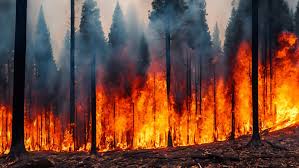Global carbon dioxide (CO₂) emissions from wildfires increased by 9% between March 2024 and February 2025, marking one of the sharpest year-over-year rises in recent history, according to The Guardian and climate monitoring data. The spike was fueled by extreme fire activity across the Amazon Basin, Bolivia, Canada, and multiple regions in Africa, where prolonged droughts and record heat amplified burning conditions.
Wildfires Driving a Dangerous Climate Feedback Loop
Scientists warn that the surge in wildfire emissions underscores a dangerous feedback loop: higher global temperatures intensify fires, which release vast amounts of carbon into the atmosphere, further accelerating climate change. In certain regions, emissions were three to four times higher than historical averages.
Canada, for example, experienced its worst wildfire year on record in 2024, with millions of hectares burned and smoke affecting air quality across North America and parts of Europe. Fires in the Amazon and Bolivia also contributed significantly to deforestation-related emissions.
Factors Behind the Global Emissions Spike
Researchers from the Copernicus Atmosphere Monitoring Service (CAMS) pointed to a combination of prolonged dry seasons, land-use changes, and extreme heat events, worsened by El Niño patterns, as key drivers of the global spike. “We’re witnessing a dangerous amplification of the wildfire–climate cycle,” noted a CAMS scientist. “Each fire season now shapes global carbon trends more visibly than ever before.”
Implications for Climate Policy and Forest Management
Experts emphasize that without strengthened international efforts to protect forests and curb deforestation, wildfire-driven emissions are likely to continue rising, threatening progress toward Paris Agreement climate targets. The report adds urgency to ongoing climate negotiations, highlighting the need to integrate wildfire management, carbon resilience, and sustainable land-use strategies into global environmental planning.

